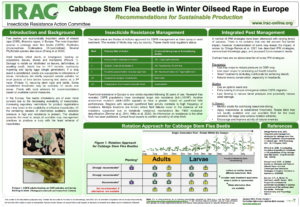Cabbage stem flea beetle
Psylliodes chrysocephalaThe cabbage stem flea beetle (CSFB) is a serious pest in winter oilseed rape with variation in abundance and damage between years. It is mainly found in Europe, but also in Canada and Russia
The adult beetles invade fields at the time of crop emergence and cause a mostly minor damage by feeding in the leaves of young plants. The main damage is caused by the larvae mining the petioles and later stems from the autumn to the following spring.
The CSFBs are univoltine and stay in the oilseed rape field most of their cycle. They have two main periods of displacement before summer diapause is to avoid unfavourably high midsummer. The displacement before summer diapause is to avoid unfavourably high temperatures. The beetles move from the fields into cooler and shadier places of higher relative humidity in field margins and hedgerows.
Their flight ability is fairly good. They are able to fly longer distances. After field invasion, their behaviour gradually changes from movement by flight to jumping.
Forecasting is widely based on monitoring the activity density of adult beetles with yellow water traps in the main period of field invasion. There is not always direct correlation between trap catches and subsequent larval density since temperature influences the number of eggs laid as well as the number of eggs hatching in the autumn
The young adult appears in May/June, the female starts to lay in autumn, stops when the temperature falls and start again at the end of the winter, in total they lay up to 150 eggs. There is one generation per year.
Adult attacks on rape seedlings can totally destroy the crop. The plants attached by the larvae become bushy and stunted.
The egg-laying of the CSFB starts in autumn and continues until flowering spring temperatures above 2 degrees. The larvae appear from autumn and overwinter as either first, second or third instars dependent on the start of egg-laying and temperature. In mild winters adults can overwinter. The larvae throughout the winter in petioles and stems of winter oilseed rape and are exposed to a physical environment of a wide range of temperatures from autumn to the following spring, potentially with sub-zero temperatures during winter. The CSFB is adapted to temperate regions with moderately cold winter conditions and is able to withstand sub-zero temperatures during winter.

